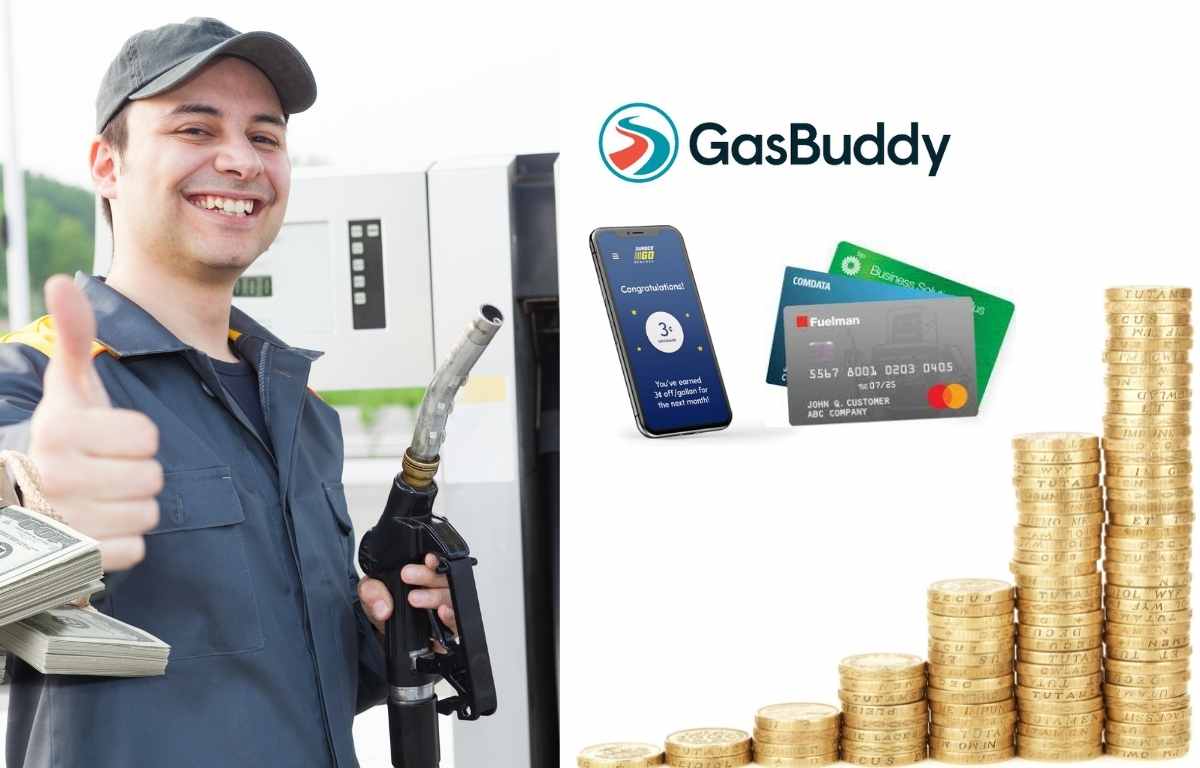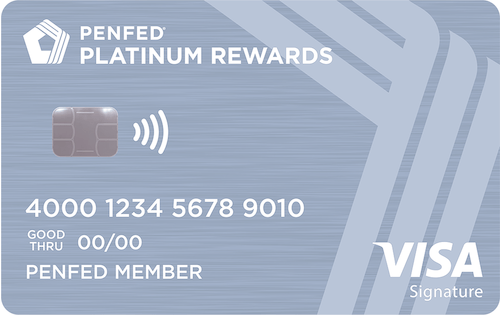While you can’t avoid high gas prices when RVing there are several things you can do to save some of your hard-earned money. You don’t need to go to elaborate steps to do this. In this article, we’ll discuss three easy strategies that you can implement to lower your fuel expenses when camping. Here they are:

1) Find the cheapest gas
2) Use a gas station loyalty/reward card
3) Use a dedicated gas credit card
If you follow these three steps, you’ll be doing all that you can to save when fueling up.
Finding cheap gas
Finding cheap gas has become much easier since the advent of the smartphone. By using a dedicated gas price app or an integrated one within your navigation system, you can easily scout out the cheapest gas near you or along your route.
Start your fuel-saving quest when choosing a gas station. Gas prices can vary widely from region to region or even from station to station. Therefore, it’s essential to think about where you’re going to fuel up when traveling. By planning your gas stops ahead of time, you will be able to have more control over what you’re paying at the pump.
Below are some of the more popular gas price apps and tools for finding cheap gas:

GasBuddy
GasBuddy is the most popular and widely used gas price apps. It’s a crowdsourced app, which means that people, just like you, are keeping it updated by entering the prices that they’re paying at the pump. In addition, GasBuddy offers individuals a chance to win a weekly $100 gas card by reporting the price they’re paying. This motivator keeps the app reasonably accurate, but it’s not perfect. Some of the complaints about the app are due to outdated gas prices. However, it’s still a helpful tool, and you can even add a custom filter for diesel or truck stops, which is a plus for people towing a trailer or driving a larger motorhome.
Gas Guru
Gas Guru is similar to GasBuddy, but the app pulls it from the Oil Price Information Service instead of crowdsourcing its price data. The app lists when the price was last updated, so it can be more accurate in some instances. It has a sleek interface and functions well.
Waze:
Similar to GasBuddy, Waze crowdsources its gas price data. If you use Waze for navigation, finding the cheapest gas is easy to do within the app. Waze also has a strong following so that the crowdsourcing data may be more accurate in some areas. However, in places where it’s less popular, you will find more inaccuracies. However, the app does let you know when the last price update was entered, which is helpful to note before you drive out of your way for cheap gas.
MapQuest:
Do you remember MapQuest, planning your trip on your computer, and printing out maps? Well, you may be surprised to learn that MapQuest is still around and much more advanced. For example, MapQuest offers a free navigation app to look up gas prices. It’s an excellent navigation tool, but best of all, it has very accurate gas prices. You can still use it on your desktop, but the best option is to download the app onto your phone. It’s not clear where it gets the data from, but it’s not crowdsourced.
Google Maps:
Google Maps has recently entered the gas price game. When using google maps, simply search for gas stations and you will see the prices displayed for many of your options. Some smaller stations may not have data or it may be outdated.
Regardless of where you get your gas data, this is a step you should take. It’s the best way to save money and with the various tools available to you, it’s quick and easy. Finding the best price on gas can easily save you 10 cents or more per gallon.
Gas Savings Cards

Now that you found the cheapest gas station, it’s time to maximize your savings. Do you remember the days of having plastic grocery cards and tags hanging from your keychain? Well, this is your opportunity to relive that experience, but without the kay chain bling. Most major gas chains offer a rewards or gas-saving program. If you’re traveling extensively, it’s a good time to register for them. Also, rather than plastic tags, most now offer a mobile app for your smartphone.
Below is a sampling of some of the more popular gas savings programs.
BPme Rewards:
After you download the app and register for an account, you’ll get 5 cents off at BP and Amoco gas stations nationwide for the month. To keep the 5-cent discount going after that, you’ll need to spend at least $100 a month on fuel from BP each calendar month. In a passenger vehicle, this can be challenging, but when pulling a trailer or driving a large motorhome, this is unfortunately easy to achieve.
The BPme Rewards app does have a unique paid feature for Price Matching. For 99 cents a month, the app will find prices at nearby competitor gas stations (within a 2-mile radius) and give you the discounted price. I haven’t tried this since there aren’t many BP or Amoco stations near me, but maybe it’s a good option for some of you.
ExxonMobil Rewards+
ExxonMobil Rewards+ is a good fuel rewards program that can save you some money. As most programs do, it incentivizes you to fuel up and shop at ExxonMobil stations. However, this rewards program is point-based and can seem confusing at first.
You will receive 3 points per gallon on fuel purchases at the most basic level, plus 2 points per dollar spent on things like car washes and convenience store items. If you’re a member of AARP, you’ll automatically earn an extra 1 point per gallon of gas and 1 point per dollar in the store. Once you get 100 points, you can spend $1.00 in rewards however you like.
Let’s say that you purchase 50 gallons of gas in a month and you’re an AARP member; you earned $2.00 in rewards. The points are equivalent to cents off per gallon; you bank it to use later rather than using it at the time of purchase.
Fueling up at ExxonMobil more frequently can save you money. For example, if you pump more than 100 gallons a month, you will earn an additional 1 cent per gallon and 2 cents per dollar- this may be achievable for you long haulers. You can also earn extra points by shopping in the store, which may be advantageous if you take advantage of monthly incentives for specific products.
Pilot Flying J Preferred Customer Rewards
Pilot Flying J’s rewards program is an excellent option for RV travelers. The stations have an RV-friendly layout, and you can be pretty confident in having enough room to fuel up. In addition, with the Preferred Customer Rewards membership, you can save 3 cents for every gallon of fuel purchased and earn points for in-store purchases.
In addition, if you’re a Good Sam member, you can receive a 5 cent per gallon discount on gas and 8 cents per gallon on Diesel when you link your two cards together. You will also receive propane and dumping discounts at eligible stations.
Shell Fuel Rewards
Shell Fuel Rewards has two tiers: Silver Status and gold status. With silver, you’ll save 3 cents per gallon on fuel purchases. With Gold, that increases to 5 cents. You automatically receive Gold status for the first six months when you sign up. After that, you’ll need to fill up six times with at least 5 gallons every three months to maintain the gold status.
Shell Fuel Rewards also offers additional ways to earn savings. Some of these include linking your card for online purchases. This benefit can include shopping online, live event tickets, or dining out at particular restaurants. Some of these incentives can be significant (5-10 cents off per gallon)
Another great feature of the Shell Rewards program is its partnership with grocery stores. You can earn considerable fuel savings by participating in grocery store incentive programs. A list of grocery stores linked to this program are:
- Dillons
- Food for Less
- Fred Meyer
- Fry’s
- Giant
- Homeland
- HyVee
- Jay C
- Kroger
- King Soopers and City Market
- PayLess
- QFC – Quality Food Centers
- Ralph’s
- Stop & Shop
- Smiths
Speedway Speedy Rewards
The Speedway Speedy Rewards has elements of all previously mentioned rewards programs. This program has many ways to earn points, and in some instances, it’s better than other programs. For example, when fueling up or shopping in the store, you’ll earn 10 points per gallon at the pump and 20 points per dollar spent in-store. They also offer bonus points on select items as well. While there are often incentives to use your points on food and beverages, fuel is the best way to maximize your savings. When you reach 1,750 points, you’ll earn 10 cents off per gallon.
The rewards programs listed above are not all of the programs available. In addition, many regional gas stations have individual programs that may be more advantageous than the national brands. Depending on where you travel the most, it may be worthwhile to investigate these options as well.
Also, you don’t need to go and sign up for every program right away. It may be easiest to stick with one or two programs to keep things organized. Finally, there is a benefit to having brand loyalty regarding fuel rewards. You’ll earn more rewards by doing this. However, you shouldn’t let a reward dictate what you pay per gallon. It is usually best to seek out the lowest price first, especially if it varies by more than a few cents.
Gas Credit Card
PenFed Platinum Rewards
Now that you located the cheapest gas and have your reward card ready, it’s now time to implement that final savings strategy: purchase using a rewards credit card.
Almost every major gas station will off their own branded fuel credit card. Some of the incentives are really nice, with an additional 5-10 cents off per gallon. If you shop at a single brand station, this may be the way to go. However, if you will be shopping at various stations, then a general cashback card will likely be more advantageous.
The absolute best gas card on the market today is the PenFed Platinum Rewards Visa Card. This card is one of the few that offer year-long cash back for gas purchases. You’ll earn 5x points for gas purchases and electric charging stations. That’s the same as 5 cents off per gallon. If you combine that with the discounts you receive through the rewards programs listed above, you could easily save more than 10 cents per gallon for every fill-up.
Additionally, when you apply, you will also receive a bonus of 15,000 points after you spend $1,500 during the first three months. That’s essentially $150 in cash back. You’ll also receive 3x bonus points for supermarket purchases, restaurants/dining, cable, satellite, and other television/radio/streaming services and 1x point on all other purchases. This card is an excellent all-around cashback card to have in your wallet. As an added benefit, there is no annual fee for this card.
Conclusion
While there isn’t anything that you can do to eliminate the strain of rising fuel costs, you can take the incremental steps above to limit it as much as possible. The less money you spend on gas, the more money you can dedicate to the rest of your camping adventures.
By following the three-step process: find the cheapest gas, receive discounts from the gas station, and get cashback on your fuel purchase, you’re on your way to lower fuel prices. But, first, let’s look at a simplified scenario:
Let’s assume you’re a moderate camper and use about 250 gallons of gas annually for camping. If you track down the cheapest gas, it’s fair to say that you’ll likely, on average, save about 10 cents per gallon vs. filling up at a random gas station. If you take advantage of a rewards program, you can take an additional 5 cents off per gallon. Finally, by using the PenFed Visa card, you’re saving another 5 cents per gallon. Combined, you could be saving 20 cents per gallon. When multiplied by your fuel needs, that can save you $50 per year for just your camping fuel needs.
If you practice this strategy with your daily driving while not camping, you can save significantly more. Most drivers in the U.S. consume over 650 gallons of gas each year. So just by practicing these simple steps, you could be saving nearly $200/year in fuel expenses, and that’s a pretty good deal.
| ReplyForward |

